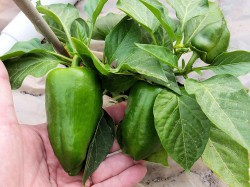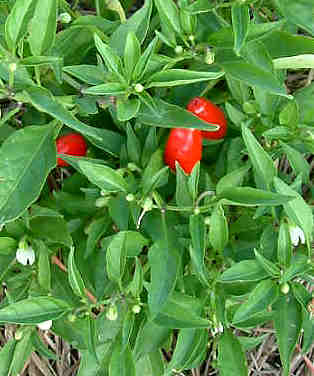How Long Do Pepper Plants Live?
How long do pepper plants live, anyway? Are they annuals, perennials or somewhere in between? Can you grow them indoors in the winter? Let’s take a look at the life of a pepper plant.
Note: In the years since I have written this post I have had more experiences with keeping pepper plants going — here’s my new post. (Read this one first, though, because it has additional information.)
Pepper Types (Species)
There are five main species of peppers:
- Capsicum annuum:Â Includes bell, sweet and many standard chile peppers like ancho, jalapeno, cayenne and more.
- Capsicum chinense:Â Includes datil, habanero and scotch bonnet peppers.
- Capsicum frutescens:Â Includes tabasco and thai peppers.
- Capsicum pubescens:Â Includes the South American rocoto peppers.
- Capsicum baccatum:Â Includes the aji peppers.
It’s important to know the species, as some are longer-lived than others. All pepper plants can be grown as annuals, but a few species can be perennial, provided they are in very warm, tropical climates.
There’s one pepper that seems to be cross-species, and that is the naga / bhut jolokia pepper. Originally called Capsicum frutescens, DNA testing has found some Capsicum chinense genes as well.
Capsicum Chinense as a Perennial
The Capsicum chinense peppers can live several years, providing they are in a warm climate. In theory, this means you can grow this species in a warm greenhouse as a perennial.
I’ve grown habaneros almost perennially here in South Florida, but I’m afraid that some of our cold snaps have done them in. This year I am trying habaneros and datils in containers, so that I can move them into the house (well, garage at any rate) when the temperatures fall below 45 degrees.
Capsicum Annuum
Your average pepper plant belonging to the species Capsicum annuum is generally grown as an annual. Although I have had some pretty long-lived jalapenos, they eventually get woody and die off.
I’ve never tried pruning a jalapeno, though, to see if I can revitalize it — that’s something I’ll have to try this year.
Although you really can’t grow them as a true perennial, Capsicum annuum can have an extended season. If you’re growing your pepper(s) in a container, you can try moving them indoors when the weather cools down. Just keep in mind that your pepper still needs plenty of sunlight; without sunlight, all the warmth in the world won’t extend your pepper’s life. That may mean a combination of south-facing window along with some supplemental light (grow lights).
Other Pepper Species
The same general rules apply to the other species; they need warmth and plenty of sunlight in order to keep growing. In their native tropical environments, the plants can live multiple years. But even in South Florida, they won’t necessarily live all year around — we do get chilly weather, and even as I write this, I’m expecting freezing temperatures tomorrow night.
So how long do pepper plants live? While they may not be perennial in the sense of living years on end, there are varieties that can grow several years — if you have the right climate.
Additional Reading
You might enjoy these related posts on peppers:
Pepper Plants and Seeds
Pepper plants and seeds are fun to work with (as you probably already know). So today is an update on the peppers and chiles that I have on deck — plants and seeds.
Bell Pepper, Yellow
This is a plant that I bought, with hopes of getting some more bells. As you’ll remember in some of my growing peppers in Florida posts, I traditionally have a hard time with bell peppers. This time I decided to just buy a plant and hope for the best.
It’s doing fairly well, and some blossoms are getting ready to appear — at least six so far. I’d have liked the plant to be a little larger, but I’ll see what happens. The size may have something to do with the fact that it’s been cooler than normal these last few weeks — days in the 60’s to low 70’s, nights in the 40’s.
Sweet Banana Peppers
The next on deck and growing well are the Sweet Banana peppers. I love the sweet bananas, and they are still a way from planting out in the garden, but they’ve been doing well, in spite of the cooler weather (I have them outdoors in a protected location).
Redskin Bell
Redskin, a bell with a “weeping” habit, is doing well. I figured I’d try another kind of bell, and grow it out on the screened patio in a pot, see what happens.
Purira Chile Pepper
I love growing the hot peppers that look like Christmas trees, with candles of all kinds of colors. Purira is a pretty hot pepper with tons and tons of cone-shaped fruits. Colors vary between ivory, yellow, purple, orange and red, with all colors appearing at any given time. Ornamental, but drop one small ripe pepper in a pot of chile and watch out!
Pretty in Purple Pepper (Hot)
Pretty in Purple is one is another of the ornamental but hot peppers. The leaves and stems are mostly purple, and the peppers are purple, ripening to red hot red. Put one or two in your chili for a nice heat.
Sweet Pickle
Name notwithstanding, I like to eat these Sweet Pickle peppers fresh. Kind of remind me of the Purira chile, with a Christmas tree appearance. These are great sliced up in salads, soups and salsa. Not hot at all — just sweet. One of these days I’ll have to try pickling them.
The Really Hot Chiles
My bhut jolokia has arrived, and I’m waiting for the mustard habaneros to show up. Thai hot, peter pepper, datil and hot-banero are also waiting in the wings. Hot-banero is the hottest habanero I’ve ever grown (my own strain), and I want to see how it stacks up against jolokia and the mustard habanero.
I’m not in a super-hurry for the really hot peppers; they like the warmth and it’s still pretty cool. In my experience, the hotter the pepper, the warmer the soil it needs to germinate, and the longer it takes to germinate. I don’t plan on putting any of the really hot chiles out in the garden until maybe the beginning of March.
But I will very shortly be germinating some jalapeno seeds — Jalapeno M variety. Debating on trying the Jaloro as well; those are some of my legacy (i.e. 10-year-old) seeds. Germination for the older seeds has been kind of low, but we’ll see what happens. Jaloro is a yellow jalapeno, instead of the usual green. But I like to use it red, which gives it a really nice kick.
Pepper Seed Varieties
I love peppers, so I am always on the lookout for new pepper seed sources. Sometimes I like hot (chile) peppers, other times I want the sweeter (bell, banana) peppers for my palate.
So was I ever surprised when I found some neat pepper seeds where I didn’t expect them — ebay!
Chile Pepper Seeds
Now when I say chile pepper, I am including all the hot peppers – not just the ones with “chile” as part of their name. And there are lots and lots of hot pepper seeds to pick!
Some of the hot pepper seed varieties I saw included
- Aji Peppers
- Ancho/Poblano
- Bhut Jolokia
, which is among the hottest peppers around.
- Cayenne peppers
- Datil peppers
- Habanero
- Jalapeno pepper
- Serrano
- Scotch bonnet
- Thai hot
- Trinadad scorpion
which is another of the world’s hottest peppers
Well, that’s just a small sampling of the hot pepper seeds that I saw — lots more varieties are available.
Sweet Peppers
Not to be outdone, there were also plenty of sweet and bell peppers available, too. I love hot chile peppers, but I also adore sweet peppers and bell peppers, too. While for whatever reason I tend to have problems with growing bells, I can grow the other sweet peppers ’til the cows come home!
Some of the interesting sweet peppers that I saw were:
There are a whole lot more of the non-chile-pepper-type seeds. I couldn’t believe the variety I saw!
Well, I need to get shopping, because fortunately, Florida summers are great for growing hot peppers (unless we get a hurricane, that is). I saw quite a few new varieties that I want to try!